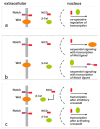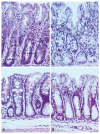Targeting Wnt Signaling via Notch in Intestinal Carcinogenesis
- PMID: 31003440
- PMCID: PMC6520938
- DOI: 10.3390/cancers11040555
Targeting Wnt Signaling via Notch in Intestinal Carcinogenesis
Abstract
Proliferation and differentiation of intestinal epithelial cells is assisted by highly specialized and well-regulated signaling cascades. The Wnt pathway, which is one of the fundamental pathways in the intestine, contributes to the organization of proliferative intestinal crypts by positioning and cycling of intestinal stem cells and their derivatives. The Wnt pathway promotes differentiation of intestinal secretory cell types along the crypt-plateau and crypt-villus axis. In contrast to the Wnt pathway, the intestinal Notch cascade participates in cellular differentiation and directs progenitor cells towards an absorptive fate with diminished numbers of Paneth and goblet cells. Opposing activities of Notch and Wnt signaling in the regulation of intestinal stem cells and the enterocytic cell fate have been elucidated recently. In fact, targeting Notch was able to overcome tumorigenesis of intestinal adenomas, prevented carcinogenesis, and counteracted Paneth cell death in the absence of caspase 8. At present, pharmacological Notch inhibition is considered as an interesting tool targeting the intrinsic Wnt pathway activities in intestinal non-neoplastic disease and carcinogenesis.
Keywords: Notch; Wnt; cancer; caspase 8; intestine; lncRNA; targeting.
Conflict of interest statement
The authors declare no conflict of interest.
Figures





Similar articles
-
Modelling the spatio-temporal cell dynamics reveals novel insights on cell differentiation and proliferation in the small intestinal crypt.PLoS One. 2012;7(5):e37115. doi: 10.1371/journal.pone.0037115. Epub 2012 May 18. PLoS One. 2012. PMID: 22623982 Free PMC article.
-
Notch inhibition counteracts Paneth cell death in absence of caspase-8.Virchows Arch. 2018 Jul;473(1):71-83. doi: 10.1007/s00428-018-2368-3. Epub 2018 May 16. Virchows Arch. 2018. PMID: 29770852
-
Nutrient sensing by absorptive and secretory progenies of small intestinal stem cells.Am J Physiol Gastrointest Liver Physiol. 2017 Jun 1;312(6):G592-G605. doi: 10.1152/ajpgi.00416.2016. Epub 2017 Mar 23. Am J Physiol Gastrointest Liver Physiol. 2017. PMID: 28336548 Free PMC article.
-
Paneth cells in intestinal physiology and pathophysiology.World J Gastrointest Pathophysiol. 2017 Nov 15;8(4):150-160. doi: 10.4291/wjgp.v8.i4.150. World J Gastrointest Pathophysiol. 2017. PMID: 29184701 Free PMC article. Review.
-
Wnt Lipidation and Modifiers in Intestinal Carcinogenesis and Cancer.Cancers (Basel). 2016 Jul 18;8(7):69. doi: 10.3390/cancers8070069. Cancers (Basel). 2016. PMID: 27438855 Free PMC article. Review.
Cited by
-
Sulindac sulfide as a non-immune suppressive γ-secretase modulator to target triple-negative breast cancer.Front Immunol. 2023 Oct 13;14:1244159. doi: 10.3389/fimmu.2023.1244159. eCollection 2023. Front Immunol. 2023. PMID: 37901240 Free PMC article.
-
Epithelial to Mesenchymal Transition: A Challenging Playground for Translational Research. Current Models and Focus on TWIST1 Relevance and Gastrointestinal Cancers.Int J Mol Sci. 2021 Oct 25;22(21):11469. doi: 10.3390/ijms222111469. Int J Mol Sci. 2021. PMID: 34768901 Free PMC article. Review.
-
Combined effect of vitamin C and vitamin D3 on intestinal epithelial barrier by regulating Notch signaling pathway.Nutr Metab (Lond). 2021 May 8;18(1):49. doi: 10.1186/s12986-021-00576-x. Nutr Metab (Lond). 2021. PMID: 33964955 Free PMC article.
-
Cytoskeletal Control and Wnt Signaling-APC's Dual Contributions in Stem Cell Division and Colorectal Cancer.Cancers (Basel). 2020 Dec 17;12(12):3811. doi: 10.3390/cancers12123811. Cancers (Basel). 2020. PMID: 33348689 Free PMC article. Review.
-
OLA1 is a potential prognostic molecular biomarker for endometrial cancer and promotes tumor progression.Oncol Lett. 2021 Aug;22(2):576. doi: 10.3892/ol.2021.12837. Epub 2021 Jun 2. Oncol Lett. 2021. PMID: 34122627 Free PMC article.
References
Publication types
Grants and funding
LinkOut - more resources
Full Text Sources

